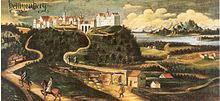17:
103:
Directly holding an
Imperial County was usually a prerequisite of membership, though from the mid 16th century onwards there were exceptions, such as 'realists' (i.e. those who held a territory actually but not directly), 'personalists' (those who had the status but not the territory) and those who
75:
The
Imperial Counts of Swabia had a permanent delegation to the Diet from 1549 onwards - their envoys also represented the Frankish Imperial Counts until 1641, when they formed their own College of Imperial Counts. In 1579 the Wetterau and Swabian Colleges created the Dinkelsbühler Union, by which
99:
As a rule, the
College's meetings took place at the same time as those of the Circle of Swabia. The heads of the member territories had the right to vote, but when a line went extinct it lost its voting rights. Initially the counts had to attend in person, but later they were allowed to send
72:. Initially Swabia was covered by the Wetterau College of Imperial Counts, since from 1495 Wetterau and Swabia both laid claim to a single vote at the Imperial Diet. It took until 1524 for the Holy Roman Emperor to firmly commit to a curial vote for the Imperial Counts of Swabia.
91:
It was headed by two directors, known as 'Grafenhauptmänner'. Below them were adjuncts as well as other officials. Without their consent no council of counts could be summoned and the directors had to seek their advice on important issues. Together with a
104:
had temporarily or permanently renounced possession of a territory. The
College formed the 'Grafenbank' in the Swabian Circle Assembly, number 98 in the ordering of the Reichsfürstenrat. All its members (except
150:
68:. At the end of the 15th century, a College of Imperial Counts was a body intended to represent the interests of nobles of the status of count and below in the
122:
145:
96:, these officials and the directors formed the Collegiate Council. All of the officials were elected for an unlimited term and later for life.
197:
76:
they internally resolved disputes between them without resorting to war and supported each other against other imperial estates.
60:
The
College was a development of various earlier bodies in the area, such as the 1407 Sankt Jörgenschild 'Knights' Society' (
168:
Die verfassungsrechtliche
Stellung des Reichsgrafenstandes vom Ausgang des Mittelalters bis zum Ende des Alten Reiches
160:
134:
79:
The
Swabian College held regular meetings from 1533 onwards, but these were interrupted between 1630 and 1645 by the
45:
20:
The Count of
Heiligenberg (from the House of Fürstenberg) took the place of honour in the Swabian Imperial College.
100:
representatives. Only a simple majority was needed until 1613, when it was changed to a two-thirds majority.
192:
127:
Historisches
Lexikon der deutschen Länder. Die deutschen Territorien vom Mittelalter bis zur Gegenwart
108:, added in 1747) were Catholics and so all belonged to the Corpus Catholicorum within the Diet.
153:. Personen, Ereignisse, Institutionen. Von der Zeitwende bis zum Ausgang des 2. Weltkrieges
80:
8:
171:
156:
130:
69:
83:. The Colleges and Union were both dissolved along with the Empire itself in 1806.
49:
65:
37:
186:
16:
93:
41:
105:
129:. 4. vollständig überarbeitete Auflage. Beck, München 1992,
155:. 2. überarbeitete Auflage. Kröner, Stuttgart 1982,
184:
48:, especially at its Imperial Council and in the
116:
15:
170:. Magisterarbeit, Wien 2008, S. 99ff.,
185:
44:to safeguard their interests in the
198:Government of the Holy Roman Empire
13:
142:Schwäbisches Reichsgrafenkollegium
30:schwäbisches Reichsgrafenkollegium
26:Swabian College of Imperial Counts
14:
209:
111:
151:Lexikon der deutschen Geschichte
86:
1:
178:
34:schwäbische Reichsgrafenbank
7:
36:) was the gathering of the
10:
214:
55:
117:Bibliography (in German)
40:and Imperial Lords of
21:
19:
166:Nikolaus Schönburg:
174:(PDF; 893 kB).
140:Wilfried Beutter:
62:Rittergesellschaft
22:
193:History of Swabia
81:Thirty Years' War
70:Holy Roman Empire
205:
50:Circle of Swabia
213:
212:
208:
207:
206:
204:
203:
202:
183:
182:
181:
119:
114:
89:
64:) and the 1488
58:
38:Imperial Counts
12:
11:
5:
211:
201:
200:
195:
180:
177:
176:
175:
164:
146:Gerhard Taddey
138:
123:Gerhard Köbler
118:
115:
113:
112:Members (1792)
110:
88:
85:
66:Swabian League
57:
54:
9:
6:
4:
3:
2:
210:
199:
196:
194:
191:
190:
188:
173:
169:
165:
162:
161:3-520-81302-5
158:
154:
152:
147:
143:
139:
136:
135:3-406-35865-9
132:
128:
124:
121:
120:
109:
107:
101:
97:
95:
84:
82:
77:
73:
71:
67:
63:
53:
51:
47:
46:Imperial Diet
43:
39:
35:
31:
27:
18:
167:
149:
141:
126:
102:
98:
90:
87:Organisation
78:
74:
61:
59:
33:
29:
25:
23:
172:Digitalisat
187:Categories
179:References
163:, S. 1129.
137:, S. 569.
28:(German:
56:History
159:
144:. In:
133:
94:syndic
42:Swabia
106:Baden
157:ISBN
131:ISBN
24:The
32:or
189::
148::
125::
52:.
Text is available under the Creative Commons Attribution-ShareAlike License. Additional terms may apply.
